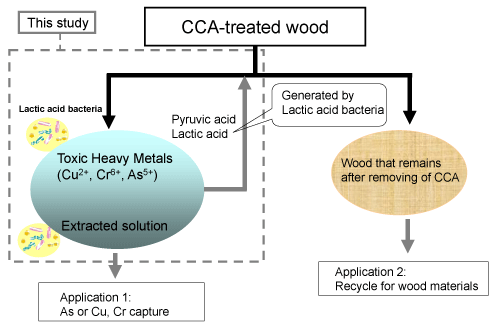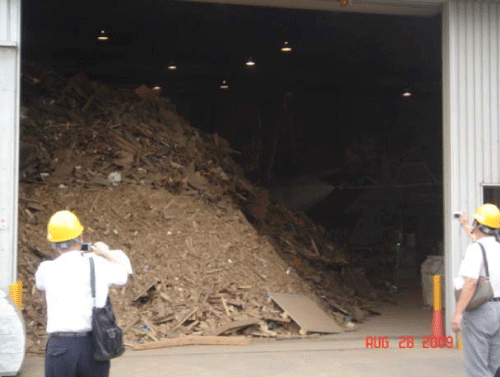Editorial Open Access
Extraction of Heavy Metals from CCA Preservative-Treated Wood Waste Using Lactic Acid Bacteria: An Environment-Friendly Technology
| Young-Cheol Chang* and Shintaro Kikuchi | |
| Division of Applied Sciences, College of Environmental Technology, Muroran Institute of Technology, 27-1 Mizumoto, Muroran 050-8585, Japan | |
| Corresponding Author : | Dr. Young-Cheol Chang Associate Professor Biosystems course Division of Applied Sciences College of Environmental Technology Muroran Institute of Technology 27-1 Mizumoto, Muroran 050-8585, Japan Tel: +81-143-46-5757 Fax: +81-143-46-5757 E-mail: ychang@mmm.muroran-it.ac.jp |
| Received: October 18, 2012; Accepted: October 19, 2012; Published: October 20, 2012 | |
| Citation:Chang YC, Kikuchi S (2012) Extraction of Heavy Metals from CCA Preservative-Treated Wood Waste Using Lactic Acid Bacteria: An Environment- Friendly Technology. J Bioremed Biodeg 3:e126. doi:10.4172/2155-6199.1000e126 | |
| Copyright: © 2012 Chang YC, et al. This is an open-a ccess article distributed under the terms of the Creative Commons Attribution License, which permits unrestricted use, distribution, and reproduction in any medium, provided the original author and source are credited. | |
Related article at Pubmed Pubmed  Scholar Google Scholar Google |
|
Visit for more related articles at Journal of Bioremediation & Biodegradation
Abstract
The recycling of wood waste is a possible solution to the global environmental concerns associated with waste. It also has economic benefits and potential environmental benefits given the global warming potential of architectural waste. The recycling method for wood waste treated with Chromated Copper Arsenate (CCA) has been a subject of concern of the architectural use of wood. The disposal of CCA-treated wood has become a serious issue in many countries, due to increasing
levels of contamination from chromium, copper and arsenic. Thus, the need to promote the recycling of the CCA treated wood waste after appropriate pre-treatment has been clearly described in the
Construction Materials Recycling Act from the Japanese Ministry of Land, Infrastructure and Transport.
| The recycling of wood waste is a possible solution to the global environmental concerns associated with waste. It also has economic benefits and potential environmental benefits given the global warming potential of architectural waste. The recycling method for wood waste treated with Chromated Copper Arsenate (CCA) has been a subject of concern of the architectural use of wood. The disposal of CCA-treated wood has become a serious issue in many countries, due to increasing levels of contamination from chromium, copper and arsenic. Thus, the need to promote the recycling of the CCA treated wood waste after appropriate pre-treatment has been clearly described in the Construction Materials Recycling Act from the Japanese Ministry of Land, Infrastructure and Transport. |
| Chemical extraction, a method that uses a chemical solvent, was known to be the most effective method for the removal efficiency of CCA preserved timber, prior to recycling [1]. However, when chemical solvents are used, an additional process for removing the remaining chemical solvent is needed because the solvent remains in the wood chips [2]. Moreover, the corrosive effects of the chemical solvent, such as a strong acid, affect the recycling ability of the timber for wood board, architectural markers, and raw materials for compost and bioethanol, due to chemical transformations. |
| Although a sophisticated method using biodegradable chelating agents (s,s-ethylenediaminedisuccinic acid and nitrilotriacetic acid) has recently been reported [3], biological extraction is still a useful and cost-effective approach for the removal of heavy metals from CCAtreated wood. Many researchers have proposed the use of biological extraction techniques as a promising approach for purifying CCAtreated wood [4-7]. In particular, the microbial production of organic acids by fungi is of growing interest in the treatment of pollution and remediation of treated wood [6,7]. With most fungi, the leaching of heavy metals is mediated by the production of organic acids, which provide a source of protons and metal complexing organic acid ions. However, it can be difficult to maintain appropriate humidity levels for fungal growth and the contamination may cause inhibition of the fungi proliferation. In addition, a culture period of 10 days or more is necessary for the leaching of CCA from CCA-treated wood [6,7] and the fungi may cause transformations of the wood constituents (lignin, cellulose, C and N). There is also a risk of allergies to the fungi [8]. |
| Recently, a new environment-friendly method using lactic acid bacteria has been developed by the authors. The concept of microbial extraction of CCA is shown in Figure 1. |
| The copper, chromium, and arsenic in the CCA-treated wood were able to be extracted by the organic acids, especially pyruvic and lactic acids, produced by the lactic acid bacterium (Lactobacillus bulgaricus NBRC13953, Lactobacillus acidophilus NBRC13951, Lactobacillus plantarum NBRC15891 and Streptococcus thermophilus NBRC13957). The CCA extraction efficiency was improved by the use of mixed cultures of two lactic acid bacteria (Lactobacillus bulgaricus and Streptococcus thermophilus) with the CCA-treated wood being almost completely extracted by a serial proceeding procedure using the two lactic acid bacteria. |
| In one of the demonstration tests, we also tried to eliminate CCA elements from a CCA-treated wood waste from a landfill site in Okinawa, Japan (Figure 2). The CCA-treated wood waste was from more than 30 years old house in Okinawa, Japan. The initial CCA concentrations of the CCA-treated wood waste were as follows: 0.27 mg arsenic ion (g dry CCA-treated wood)-1, 0.48 mg copper ion (g dry CCA-treated wood)-1, and 0.89 mg chromium ion (g dry CCA-treated wood)-1. The experiment was performed for 3 days by the two-step processing procedure using Lactobacillus bulgaricus and Streptococcus thermophiles [9]. As a result, the concentrations of remaining CCA elements (arsenic, copper, and chromium) in the wood waste after the two-step processing procedure was observed below the maximum values indicated in the German Closed Substance Cycle and Waste Management Act [10]. This result indicates that the two-step processing procedure using Lactobacillus bulgaricus and Streptococcus thermophilus could be useful for eliminating CCA elements from low concentrations of CCA-treated wood wastes existing in landfill sites. |
| Although the practical applications of this method using lactic acid bacteria have yet to be explored, these results are interesting in providing a new option for the extraction of CCA from CCA-treated wood. |
| The potential advantages of this technique are numerous. Collaboration between environmental engineers and microbiologists is required to bring this promising technology to fruition. |
References
|
Figures at a glance
 |
 |
| Figure 1 | Figure 2 |
Relevant Topics
- Anaerobic Biodegradation
- Biodegradable Balloons
- Biodegradable Confetti
- Biodegradable Diapers
- Biodegradable Plastics
- Biodegradable Sunscreen
- Biodegradation
- Bioremediation Bacteria
- Bioremediation Oil Spills
- Bioremediation Plants
- Bioremediation Products
- Ex Situ Bioremediation
- Heavy Metal Bioremediation
- In Situ Bioremediation
- Mycoremediation
- Non Biodegradable
- Phytoremediation
- Sewage Water Treatment
- Soil Bioremediation
- Types of Upwelling
- Waste Degredation
- Xenobiotics
Recommended Journals
Article Tools
Article Usage
- Total views: 14621
- [From(publication date):
December-2012 - Nov 29, 2025] - Breakdown by view type
- HTML page views : 9804
- PDF downloads : 4817
